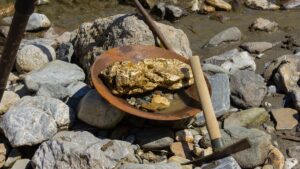Great Boulder records high-grade gold in first Mulga Bill diamond holes

Pic: John W Banagan / Stone via Getty Images
Visible gold with grades topping up at 38.4g/t have been returned from initial priority assays of Great Boulder’s first diamond drilling at the Mulga Bill prospect.
Results from partial sections within the first three holes include the top 1m intersection – where visible gold was observed – grading 38.4 grams per tonne gold from a depth of 129.3m (22MBDD002), and 3.08m at 4.57g/t gold from 141.97m including 0.38m at 30.1g/t gold, 1.01% copper and 4.44g/t silver within a sulphide-rich zone at 22MBDD001.
And there’s more to come for Great Boulder Resources (ASX:GBR) with visible gold also observed in subsequent intersections that have yet to be assayed.
“These holes were planned to target narrow high-grade vein positions so we’re excited to see visible gold, intense alteration and high gold grades within those veins,” managing director Andrew Paterson said.
“The diamond program has been very important in providing more structural data, particularly the orientations of these vein sets.
“We are now looking forward to receiving the rest of the assays. Meanwhile the RC program is continuing smoothly and we’re busy recruiting exploration personnel to start accelerating our field program at Mulga Bill.”
Drill results
Besides the results highlighted above, the initial assays also included the following results:
- 1.7m at 6.52g/t gold from 167.7m in including 0.45m at 16.55g/t gold from 167.7m and 0.5m at 6.85g/t gold from 168.9m (22MBDD001); and
- 0.96m at 12.99g/t gold from 199m including 0.2m at 42g/t gold from 199m (22MBDD003).
The intersections in 22MBDD001 support the interpretation of narrow sub-vertical high-grade lodes related to the regional north-south shear zone that runs through the area.
Multiple individual lodes are now interpreted to trend north-south through this central section of Mulga Bill.
Hole 22MBDD002 suffered from intervals of core loss within the hole, including one section immediately after the high-grade vein with visible gold.
Further diamond results are expected between May and June while drilling has resumed after a temporary delay in late March due to wet weather.
Results from the recently completed 3D induced polarisation survey will also be released once data processing and interpretation is finished.
Whiteheads gold exploration
Meanwhile, aircore drilling at the Whiteheads has defined gold mineralisation over more than 2.5km of strike at the Arsenal Trend.
Results such as 4m at 0.77g/t gold from 32m and 4m at 0.91g/t gold from 48m highlight the area as an ongoing priority for drilling as they compare favourably to the discovery at Blue Poles, where thick zones of supergene mineralisation were found by RC drilling beneath AC anomalies.
“We need to drill deeper RC at holes at Blue Poles to test the higher-grade potential plunging to the south, and then start testing these new prospects south of Blue Poles,” Paterson added.
Great Boulder is also awaiting assays from over 900 auger samples recently completed in the Wishbone area and will have the AC rig back at Whiteheads in about a month to continue first-pass drilling on additional geochemical targets.
This article was developed in collaboration with Great Boulder Resources, a Stockhead advertiser at the time of publishing.
This article does not constitute financial product advice. You should consider obtaining independent advice before making any financial decisions.
Related Topics

UNLOCK INSIGHTS
Discover the untold stories of emerging ASX stocks.
Daily news and expert analysis, it's free to subscribe.
By proceeding, you confirm you understand that we handle personal information in accordance with our Privacy Policy.








